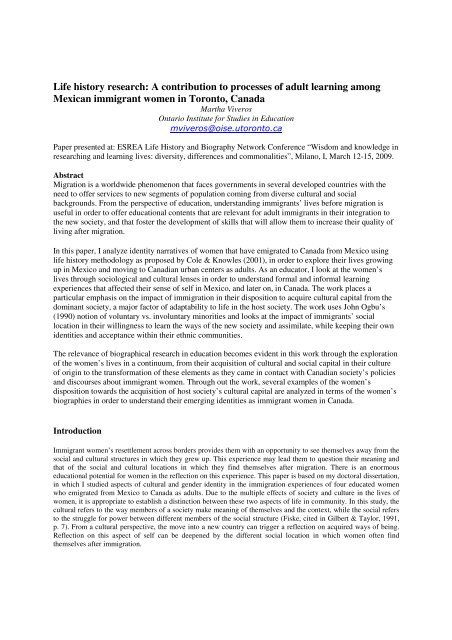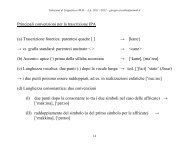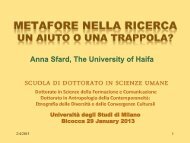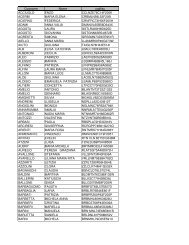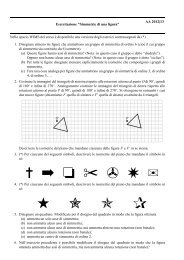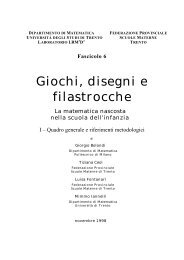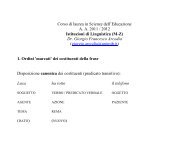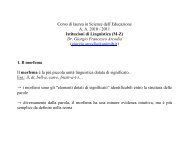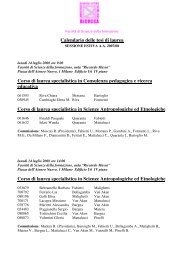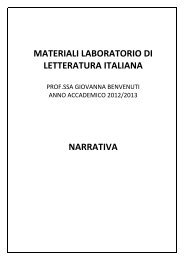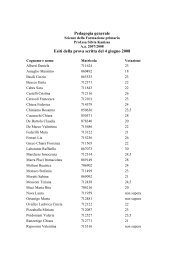Life history research: A contribution to processes of adult learning ...
Life history research: A contribution to processes of adult learning ...
Life history research: A contribution to processes of adult learning ...
You also want an ePaper? Increase the reach of your titles
YUMPU automatically turns print PDFs into web optimized ePapers that Google loves.
<strong>Life</strong> <strong>his<strong>to</strong>ry</strong> <strong>research</strong>: A <strong>contribution</strong> <strong>to</strong> <strong>processes</strong> <strong>of</strong> <strong>adult</strong> <strong>learning</strong> among<br />
Mexican immigrant women in Toron<strong>to</strong>, Canada<br />
Martha Viveros<br />
Ontario Institute for Studies in Education<br />
mviveros@oise.u<strong>to</strong>ron<strong>to</strong>.ca<br />
Paper presented at: ESREA <strong>Life</strong> His<strong>to</strong>ry and Biography Network Conference “Wisdom and knowledge in<br />
<strong>research</strong>ing and <strong>learning</strong> lives: diversity, differences and commonalities”, Milano, I, March 12-15, 2009.<br />
Abstract<br />
Migration is a worldwide phenomenon that faces governments in several developed countries with the<br />
need <strong>to</strong> <strong>of</strong>fer services <strong>to</strong> new segments <strong>of</strong> population coming from diverse cultural and social<br />
backgrounds. From the perspective <strong>of</strong> education, understanding immigrants’ lives before migration is<br />
useful in order <strong>to</strong> <strong>of</strong>fer educational contents that are relevant for <strong>adult</strong> immigrants in their integration <strong>to</strong><br />
the new society, and that foster the development <strong>of</strong> skills that will allow them <strong>to</strong> increase their quality <strong>of</strong><br />
living after migration.<br />
In this paper, I analyze identity narratives <strong>of</strong> women that have emigrated <strong>to</strong> Canada from Mexico using<br />
life <strong>his<strong>to</strong>ry</strong> methodology as proposed by Cole & Knowles (2001), in order <strong>to</strong> explore their lives growing<br />
up in Mexico and moving <strong>to</strong> Canadian urban centers as <strong>adult</strong>s. As an educa<strong>to</strong>r, I look at the women’s<br />
lives through sociological and cultural lenses in order <strong>to</strong> understand formal and informal <strong>learning</strong><br />
experiences that affected their sense <strong>of</strong> self in Mexico, and later on, in Canada. The work places a<br />
particular emphasis on the impact <strong>of</strong> immigration in their disposition <strong>to</strong> acquire cultural capital from the<br />
dominant society, a major fac<strong>to</strong>r <strong>of</strong> adaptability <strong>to</strong> life in the host society. The work uses John Ogbu’s<br />
(1990) notion <strong>of</strong> voluntary vs. involuntary minorities and looks at the impact <strong>of</strong> immigrants’ social<br />
location in their willingness <strong>to</strong> learn the ways <strong>of</strong> the new society and assimilate, while keeping their own<br />
identities and acceptance within their ethnic communities.<br />
The relevance <strong>of</strong> biographical <strong>research</strong> in education becomes evident in this work through the exploration<br />
<strong>of</strong> the women’s lives in a continuum, from their acquisition <strong>of</strong> cultural and social capital in their culture<br />
<strong>of</strong> origin <strong>to</strong> the transformation <strong>of</strong> these elements as they came in contact with Canadian society’s policies<br />
and discourses about immigrant women. Through out the work, several examples <strong>of</strong> the women’s<br />
disposition <strong>to</strong>wards the acquisition <strong>of</strong> host society’s cultural capital are analyzed in terms <strong>of</strong> the women’s<br />
biographies in order <strong>to</strong> understand their emerging identities as immigrant women in Canada.<br />
Introduction<br />
Immigrant women’s resettlement across borders provides them with an opportunity <strong>to</strong> see themselves away from the<br />
social and cultural structures in which they grew up. This experience may lead them <strong>to</strong> question their meaning and<br />
that <strong>of</strong> the social and cultural locations in which they find themselves after migration. There is an enormous<br />
educational potential for women in the reflection on this experience. This paper is based on my doc<strong>to</strong>ral dissertation,<br />
in which I studied aspects <strong>of</strong> cultural and gender identity in the immigration experiences <strong>of</strong> four educated women<br />
who emigrated from Mexico <strong>to</strong> Canada as <strong>adult</strong>s. Due <strong>to</strong> the multiple effects <strong>of</strong> society and culture in the lives <strong>of</strong><br />
women, it is appropriate <strong>to</strong> establish a distinction between these two aspects <strong>of</strong> life in community. In this study, the<br />
cultural refers <strong>to</strong> the way members <strong>of</strong> a society make meaning <strong>of</strong> themselves and the context, while the social refers<br />
<strong>to</strong> the struggle for power between different members <strong>of</strong> the social structure (Fiske, cited in Gilbert & Taylor, 1991,<br />
p. 7). From a cultural perspective, the move in<strong>to</strong> a new country can trigger a reflection on acquired ways <strong>of</strong> being.<br />
Reflection on this aspect <strong>of</strong> self can be deepened by the different social location in which women <strong>of</strong>ten find<br />
themselves after immigration.
There is a vital interconnection between voice, identity, and place. The analyses <strong>of</strong> the four participants’ experiences<br />
<strong>of</strong> identity modification after immigration consisted <strong>of</strong> observing what they expressed about themselves in<br />
connection with the different places in which they have lived. In telling their s<strong>to</strong>ries I included my own, since the<br />
search for self-understanding after the experience <strong>of</strong> immigration was the initial inspiration for this project. The<br />
unravelling <strong>of</strong> labels like Mexican, woman, Latin American, Canadian, immigrant, middle-class, and educated, was<br />
part <strong>of</strong> the process; they are layers that I encountered when exploring the sense <strong>of</strong> who I am because <strong>of</strong> these social<br />
locations and beyond them. <strong>Life</strong> away from Mexico <strong>of</strong>fered the four participants and myself the opportunity <strong>to</strong><br />
identify and analyze these labels, and <strong>to</strong> become aware <strong>of</strong> the ways in which they shaped us in our country <strong>of</strong> origin<br />
and the new one as well.<br />
Informal conversations with other Mexican women living in Canada sparked my interest in the <strong>to</strong>pics <strong>of</strong> gender and<br />
identity. My friends spoke about the way life in Canada helped them discover parts <strong>of</strong> themselves they were not<br />
aware <strong>of</strong> before. I heard friends speak about how their choice <strong>to</strong> live in Canada was not necessarily based on<br />
financial opportunities, but rather on the quality <strong>of</strong> the lives they lead in Canada, which they felt was not attainable<br />
in Mexico. Gender-based expectations can be a considerable source <strong>of</strong> pressure for women; a change in cultural<br />
context can alleviate some <strong>of</strong> that pressure (Espin, 1999). Even though the four participants are <strong>adult</strong> women whose<br />
ages range between mid-thirties and early sixties, their s<strong>to</strong>ries remind me <strong>of</strong> Karen Close’s (2001) concept <strong>of</strong> the<br />
unfinished woman. Regardless <strong>of</strong> their age, these women intuitively knew there was a part <strong>of</strong> themselves that was<br />
missing in order <strong>to</strong> launch lives that fully represented their convictions and potential. For a variety <strong>of</strong> reasons, the<br />
Canadian context <strong>of</strong>fered them this possibility.<br />
Adela, Papalotl, Gloria and Erica’s life his<strong>to</strong>ries are s<strong>to</strong>ries <strong>of</strong> individual lives shaped by <strong>his<strong>to</strong>ry</strong>, politics, society<br />
and culture in Mexico and Canada. Characteristics <strong>of</strong> their Mexican context such as class, education, age and<br />
personal values are all ingredients in the recreation <strong>of</strong> their new life in Canada. Their s<strong>to</strong>ries are as much about what<br />
it <strong>to</strong>ok them <strong>to</strong> settle in the country as immigrants as about the path each one <strong>of</strong> them <strong>to</strong>ok in order <strong>to</strong> find “their<br />
place” in Canadian society. Initially, the lack <strong>of</strong> personal networks and a solid, Mexican community in the Canadian<br />
cities in which they live posed a challenge; yet, at the same time, the lack <strong>of</strong> a familiar ethnic community was<br />
liberating. For them, the interaction with unknown cultural and social ways stimulated the self-definition<br />
mechanisms (Reygadas, 2002). In these conditions, immigration represents an opportunity <strong>to</strong> re-imagine the self,<br />
individually and collectively—as Mexicans, as women and at different levels <strong>of</strong> their personal lives.<br />
The <strong>research</strong> questions that initiated this work were the following: How do immigrant women recreate themselves<br />
after migration? What do they learn about themselves as women by being in Canada? How have they been affected<br />
by the context in which they now live (socially, pr<strong>of</strong>essionally, physically, and emotionally)? My interest was <strong>to</strong><br />
understand whether the participants experience immigration as an opportunity <strong>to</strong> revise their previous knowledge<br />
and create new one – both about self and context—from a gender perspective. <strong>Life</strong> <strong>his<strong>to</strong>ry</strong> methodology was ideal<br />
for this purpose, since the revision <strong>of</strong> their biographical s<strong>to</strong>ries allowed for the identification <strong>of</strong> previous and new<br />
conceptions <strong>of</strong> self. In order <strong>to</strong> do this, I explored the concept <strong>of</strong> identity, as well as notions <strong>of</strong> colonialism and the<br />
connection between gender and immigration. The theoretical lenses included elements <strong>of</strong> critical theory and<br />
feminism, as well as cultural studies theory that explain the connections between culture and identity (Hall, 1996).<br />
In educational settings, the understanding and acknowledgement <strong>of</strong> immigrants’ cultural backgrounds can lead <strong>to</strong><br />
more effective ways <strong>of</strong> creating educational contexts that truly support them <strong>to</strong> become active, integrated members<br />
<strong>of</strong> their new society. The four study participants, like a vast majority <strong>of</strong> immigrants <strong>to</strong> Canada, can be placed under<br />
the category that John Ogbu (1990) calls voluntary minorities. In this context, immigrants’ belief that life in Canada<br />
will bring about improvement for themselves and their families predisposes them <strong>to</strong> acquire different kinds <strong>of</strong><br />
knowledge that will favor their transition in<strong>to</strong> Canadian society. The four participants’ s<strong>to</strong>ries <strong>of</strong>fer numerous<br />
examples <strong>of</strong> ways in which the women actively sought <strong>to</strong> learn “Canadian ways” in order <strong>to</strong> become part <strong>of</strong> their<br />
new society in meaningful forms that are in line with their values and identities. Educa<strong>to</strong>rs must be aware <strong>of</strong> the fact<br />
that, in spite <strong>of</strong> immigrants’ willingness <strong>to</strong> embrace the ways <strong>of</strong> the new society, their original identity, values and<br />
knowledge must be recognized, respected, and drawn upon in order <strong>to</strong> support their integration in<strong>to</strong> the new society.<br />
This is the only way <strong>of</strong> contributing <strong>to</strong> immigrants’ integration while keeping them whole and healthy as individuals<br />
and in communities.<br />
The Method: Voice, Knowledge and <strong>Life</strong> His<strong>to</strong>ry
<strong>Life</strong> <strong>his<strong>to</strong>ry</strong> methodology was organic <strong>to</strong> the nature <strong>of</strong> this inquiry; its emphasis on the intersection <strong>of</strong> individual<br />
lives and context made it an excellent way <strong>to</strong> explore the meaning <strong>of</strong> the immigration and settlement experiences in<br />
women’s lives (Cole & Knowles, 2001). It was precisely this intersection that revealed information about women’s<br />
oppression, and at the same time, their windows <strong>of</strong> agency. When I speak about context, I refer <strong>to</strong> multiple<br />
dimensions: the physical locations that are crucial <strong>to</strong> the participants’ lives, my position and biases as <strong>research</strong>er, the<br />
his<strong>to</strong>rical, cultural and ideological milieu in which the participants’ lives are lived and lastly, the ways in which the<br />
women shaped their context (Lawrence-Lightfoot, 1997). The lives <strong>of</strong> immigrants do not start when they reach the<br />
host country, but in the country (ies) that shaped their sense <strong>of</strong> self throughout their lives. The participants’ prior<br />
locations, both geographic and social, were key <strong>to</strong> understanding their current locations in Canadian society, as well<br />
as any changes in their sense <strong>of</strong> identity after immigration. A biographical study with an emphasis on the women’s<br />
his<strong>to</strong>rical, social and cultural locations provided the key <strong>to</strong> see them in this light. My interest was <strong>to</strong> understand the<br />
aspects <strong>of</strong> culture in Mexico and Canada that affect educated women when they immigrate; my position as a new<br />
immigrant allowed me <strong>to</strong> explore this experience from the inside.<br />
About The Researcher and Other Aspects <strong>of</strong> the Research Process<br />
From a traditional, positivistic perspective, the <strong>research</strong>er holds a position <strong>of</strong> power: that <strong>of</strong> seeing without being<br />
seen. I did not follow this stance in my <strong>research</strong> process; instead, I followed the principles <strong>of</strong> relationality, empathy<br />
and mutuality described by Cole & Knowles (2001). Part <strong>of</strong> my initial difficulty was my fear <strong>of</strong> “losing face” as<br />
<strong>research</strong>er by sharing my experiences with the participants. Yet, the fact that I have shared aspects <strong>of</strong> my life with<br />
the participants made writing the life <strong>his<strong>to</strong>ry</strong> an exercise <strong>of</strong> giving voice, both <strong>to</strong> the other women and myself. This<br />
idea in itself summarizes the way <strong>research</strong> and life merge: giving voice <strong>to</strong> the women, the <strong>research</strong>er and the self as<br />
a way <strong>of</strong> finding balance in the academy and in life. The mixture <strong>of</strong> personal and pr<strong>of</strong>essional, individual and social<br />
was a powerful way <strong>to</strong> gain insight on the lives <strong>of</strong> the four immigrant women. The mix <strong>of</strong> scholarly analysis,<br />
solidarity and self-expression brings scholarly work closer <strong>to</strong> people beyond academic settings (Feathers<strong>to</strong>ne, cited<br />
in Lawrence-Lightfoot, 1997, p. 10).<br />
My choice <strong>of</strong> participants reflected a personal intention: <strong>to</strong> understand the transition and the experiences <strong>of</strong><br />
transformation I sensed through my own experience <strong>of</strong> life in Canada. Following an intuited perception that I could<br />
not articulate at the time, I selected participants that were at different stages in their lives and that reflected various<br />
aspects <strong>of</strong> myself. Gloria represented the importance <strong>of</strong> developing a career as an independent woman. Papalotl,<br />
who is a pr<strong>of</strong>essional dancer, represented my affinity with embodied knowledge through my yoga practice. Adela<br />
reconnected me with the vibrancy <strong>of</strong> the arts and culture that I was familiar with in my years as an undergraduate<br />
student. Erica’s accounts helped me reflect on some aspects <strong>of</strong> social privilege that shaped my life directly and<br />
indirectly. I wrote about their s<strong>to</strong>ries hoping that other Mexican women who live in Canada could see themselves in<br />
them. It is difficult <strong>to</strong> come across writings about immigrant women from relatively privileged<br />
backgrounds. It may be that people think their privilege outside Canada makes them immune <strong>to</strong> hardship<br />
or oppression when they immigrate, or that they need less support from the system and are therefore not<br />
studied as intensely. However, these women also go through transformation and challenges that force<br />
them <strong>to</strong> adapt and grow and that eventually affects their sense <strong>of</strong> who they are. The women’s s<strong>to</strong>ries<br />
revealed the complex nature <strong>of</strong> privilege and its impact on individual lives.<br />
The four women I interviewed went through extensive <strong>processes</strong> <strong>of</strong> reconstructing their lives in Canada<br />
after immigration. Listening <strong>to</strong> them allowed me <strong>to</strong> shape a narrative—<strong>of</strong> which I only include small<br />
sections here—that tells their s<strong>to</strong>ries as well as mine, weaving in the socio-cultural similarities and<br />
differences that shaped their lives before and after immigration, and that allowed them <strong>to</strong> “become<br />
Canadian” in diverse manners. For them, life in Canada was a transforming experience; in this new,<br />
Northern country they found pieces <strong>of</strong> themselves they were not aware <strong>of</strong> in Mexico. Adela emerged as a<br />
social activist, Papalotl incorporated her full ethnic identity in<strong>to</strong> her life, Gloria became a mother and a<br />
transnational businesswoman, Erica had her dream <strong>of</strong> pr<strong>of</strong>essional advancement in the developed world<br />
come true in Canada. For me, this time allowed <strong>to</strong> find and articulate my voice as an academic and an<br />
immigrant woman. The life s<strong>to</strong>ries in this work evidence the process <strong>of</strong> finding voice in order <strong>to</strong> gain<br />
control over lives (Belenky, Clinchy, Goldberger & Tarule, 1986).
Immigration: The Power <strong>of</strong> a Transition<br />
Immigration can be a powerful catalyst for self-transformation because it causes the reorganization <strong>of</strong><br />
immigrants’ sense <strong>of</strong> who they are. Immigrants relate <strong>to</strong> the new context in different ways; they may<br />
choose <strong>to</strong> separate, assimilate or integrate <strong>to</strong> the host society (Walters et al., 2007). If they choose <strong>to</strong><br />
separate from the main stream they may cling nostalgically <strong>to</strong> the past and refuse <strong>to</strong> become part <strong>of</strong> what<br />
is new. If they choose <strong>to</strong> assimilate, they may tend <strong>to</strong> remain detached from their ethnic communities in<br />
the country in order <strong>to</strong> merge with the main group in society. If they integrate they will choose a<br />
combination <strong>of</strong> elements <strong>of</strong> both cultures in the recreation <strong>of</strong> their new lifestyle and sense <strong>of</strong> self. The fact<br />
that immigrants have choice in the way they relate <strong>to</strong> the new context points <strong>to</strong> the interplay between<br />
individual agency and the shaping forces <strong>of</strong> the context, both in their native country and in the new one.<br />
In <strong>adult</strong>hood, this interplay defines a person’s sense <strong>of</strong> identity. As Giddens (1971) says, identity has a<br />
prominent position within the debate about the relationships between structure and individual agency.<br />
Oftentimes, people think the <strong>learning</strong> that immigrants experience is exclusively related practical matters<br />
such as language or pr<strong>of</strong>essional training; yet, immigration involves <strong>learning</strong> how <strong>to</strong> cope in the new<br />
culture from a cognitive, attitudinal and behavioral perspective (Rong & Brown, 2002). When I first<br />
arrived in Toron<strong>to</strong> I spoke English; I was very familiar with grammar and vocabulary; I studied English in<br />
a Mexican classroom for seventeen years. Knowing the structure <strong>of</strong> a language though, does not mean<br />
that one knows its nuances well enough <strong>to</strong> communicate with the same ease with which one uses the<br />
mother <strong>to</strong>ngue. In spite <strong>of</strong> my language skills, I did not know how <strong>to</strong> navigate social situations with the<br />
right words and phrases when I first arrived in Toron<strong>to</strong>. Seven years later, I am still <strong>learning</strong>. Crosscultural<br />
experience involves awakening, transformation <strong>of</strong> identity and overlapping <strong>of</strong> cultural meanings,<br />
landscapes and languages (He, 2002 in Koehne, 1995). Learning <strong>to</strong> communicate with others and find a<br />
place at the university required much more than the language skills <strong>of</strong>fered in bilingual education<br />
classrooms. Host countries must consider these dimensions <strong>of</strong> the immigration experience when<br />
designing educational contents <strong>to</strong> easy immigrants’ transition in<strong>to</strong> their new country.<br />
Understanding the changes in sense <strong>of</strong> self and lifestyle that come about as a result <strong>of</strong> immigration<br />
implies the observation <strong>of</strong> the individual and the social, the realms <strong>of</strong> family and culture, the<br />
psychological and the sociological. The exploration <strong>of</strong> one <strong>to</strong>ok me <strong>to</strong> the other, back and forth, in order<br />
<strong>to</strong> understand the complexity <strong>of</strong> (re) developing a self that lives in two different cultures. There are many<br />
aspects <strong>to</strong> this duality: personal ones such as the sense <strong>of</strong> self and self-worth, and social ones, such as<br />
cultural identity and the politics that surround it. The study focused on both the personal and the social, as<br />
they relate <strong>to</strong> the (re)formation <strong>of</strong> an individual identity in relationship <strong>to</strong> the context in which the life is<br />
lived. At the center <strong>of</strong> this exploration lies <strong>to</strong> notion <strong>of</strong> the genealogy <strong>of</strong> discourse: the way power<br />
structures manufacture particular subjectivities that individuals internalize and transform in<strong>to</strong> the truth<br />
about themselves (Foucault cited in Koehne, 2005). We are the product <strong>of</strong> all the s<strong>to</strong>ries we have heard<br />
and lived, and <strong>of</strong> many that we have never heard (Taylor, 1996). The biographical study <strong>of</strong> immigrants’<br />
lives <strong>of</strong>fers the possibility <strong>to</strong> uncover and explore these s<strong>to</strong>ries. Through the life s<strong>to</strong>ries <strong>of</strong> four women, I<br />
explore the question <strong>of</strong> the role <strong>of</strong> agency in the face <strong>of</strong> various possible identity discourses for<br />
immigrants in the Canadian context. In Canada, Papalotl, Adela, Gloria and Erica each saw their lives<br />
take turns they would not have expected in Mexico. They all spoke about limiting boundaries Mexican<br />
culture imposed on them in different areas <strong>of</strong> their lives: pr<strong>of</strong>essional development, parenting practices, or<br />
decision-making in general. The four women connected limitations in these and other areas <strong>of</strong> their lives<br />
<strong>to</strong> gender-related values that are part <strong>of</strong> the Mexican cultural context.<br />
Immigration <strong>to</strong> the “Developed World”: Motivations<br />
The quality <strong>of</strong> the four women’s experiences in Canada is very different; the differences stem from the
motivations that led them <strong>to</strong> immigrate, as well as from their location in Mexican society. Papalotl and<br />
Adela emigrated seeking personal growth; self-expression and answers that they did not find in Mexico<br />
and hoped <strong>to</strong> find by moving in<strong>to</strong> a new context. It was not that someone or something in Canada would<br />
have the answer, but that being in Canada would create the space for the answer <strong>to</strong> become apparent.<br />
Erica by contrast, had a much more pragmatic approach; she went <strong>to</strong> Ottawa looking for better financial<br />
opportunities. She had a stable job in her field in Mexico but she and her husband believed they would<br />
find even better opportunities in Canada. Gloria came <strong>to</strong> Canada for the first time in the 1970s, seeking<br />
both relief from burdening social pressure for becoming a single mother in Mexico, as well as educational<br />
opportunities for pr<strong>of</strong>essional advancement. I came <strong>to</strong> Canada looking for a safe space <strong>to</strong> do selfexploration.<br />
My experience was semi-structured. I went <strong>to</strong> graduate school and simultaneously found time<br />
<strong>to</strong> explore other aspects <strong>of</strong> my life that were important <strong>to</strong> me, such as expressive art and meditative<br />
practices. The interplay between structural conditions and individual choices is present in each one <strong>of</strong><br />
these lives. For each one <strong>of</strong> the women, agency involved individual decision-making, as well as the<br />
creative orchestration <strong>of</strong> cultural elements (Lester cited in Ruiz & Sanchez Korrol, 2005). Papalotl, Adela,<br />
Gloria and Erica negotiated identity and location at every step <strong>of</strong> the way.<br />
Despite Erica’s or Gloria’s desire for a brighter financial future, none <strong>of</strong> us—myself included—were<br />
economic migrants. We all had access <strong>to</strong> jobs that provided enough money <strong>to</strong> live and certain career<br />
development perspectives yet, we were all looking for “something else” that did not translate exclusively<br />
in<strong>to</strong> higher financial gains. After listening <strong>to</strong> the s<strong>to</strong>ries, I realized that the four women’s decisions <strong>to</strong><br />
immigrate revealed deeper values and ways <strong>of</strong> living. In the context <strong>of</strong> the developed world, Richard<br />
Florida (2002) has spoken about place as the social organizing unit <strong>of</strong> our time. None <strong>of</strong> these women had<br />
a strict necessity <strong>to</strong> leave Mexico. None <strong>of</strong> them suffered from violence or political prosecution yet, they<br />
all felt they needed <strong>to</strong> find a different place <strong>to</strong> live. For career-ambitious women like Gloria and Erica,<br />
who looked for the best place <strong>to</strong> thrive pr<strong>of</strong>essionally, Oakville and Ottawa were highly appealing. For<br />
Adela and Papalotl, whose interests gravitate <strong>to</strong>wards social and cultural work, Toron<strong>to</strong> was an attractive<br />
city. Toron<strong>to</strong>’s diversity generates <strong>to</strong>lerance <strong>to</strong>wards difference, as well as community work aimed at<br />
supporting immigrants and fight issues that arise in the context <strong>of</strong> a multicultural society. In this sense,<br />
Toron<strong>to</strong> was an ideal place for me as well.<br />
Immigrant Women: Who Defines Our Identities?<br />
The well-known Chicana writer Gloria Anzaldua described the conflicts <strong>of</strong> living in the borderland<br />
between two or more cultures accurately. She writes about mestizas being the product <strong>of</strong> two cultures,<br />
having yet <strong>to</strong> embrace a third one. Embracing the third culture, in this case a possible version <strong>of</strong> Mexican<br />
culture in Canada, implies making a synthesis <strong>of</strong> the previous being, knowing what one wants <strong>to</strong> keep and<br />
what one does not, in order <strong>to</strong> create the new self. In this context, the creation <strong>of</strong> an identity is involved in<br />
a game <strong>of</strong> mirrors—the way I see myself versus the way others see me based on their social location.<br />
Interestingly enough, Canada’s identity as a nation is also part <strong>of</strong> a game <strong>of</strong> reflections with a status as a<br />
white, settler nation, and its imagined self-identity as a nation <strong>of</strong> immigrants that, at the same time has a<br />
difficult <strong>his<strong>to</strong>ry</strong> as the colonizer <strong>of</strong> various aboriginal communities (Epp, Iacovetta & Swyripa, 2004).<br />
Anzaldua (1987), who lived in the United States, spoke about knowing how <strong>to</strong> be a Mexican from an<br />
Anglo point <strong>of</strong> view. Among people in the developed world, there is a stereotype <strong>of</strong> Third World women<br />
as poor, submissive and uneducated (Thobani, 1998). Increasingly, immigrants <strong>to</strong> Canada come from<br />
developing countries (Statistics Canada, 2006); a lot <strong>of</strong> women enter the country and are seen through the<br />
lens <strong>of</strong> this preconception. Socio-economic differences in the country <strong>of</strong> origin are <strong>of</strong>tentimes unseen by<br />
people in Canada who tend <strong>to</strong> imagine all Mexican women under a similar socioeconomic category. The<br />
participants in this study do not fit in<strong>to</strong> traditional stereotypes <strong>of</strong> Latinas, as they are, in varying levels<br />
and degrees, educated, progressive women. Those women are not a representative majority in the country<br />
but their realities are very different from the stereotypes <strong>of</strong> the typical “Third World woman” that is
present in the developed world. At a personal level, these stereotypes affect relationships; at a systemic<br />
level they affect women’s well-being and opportunities for advancement.<br />
Immigrant women need <strong>to</strong> develop their voices and re-create themselves consciously; the creation <strong>of</strong><br />
women’s life his<strong>to</strong>ries can be what Chandra Mohanty calls "a discourse <strong>of</strong> oppositional consciousness and<br />
agency". The practice <strong>of</strong> remembering "against the grain <strong>of</strong> 'public' or hegemonic <strong>his<strong>to</strong>ry</strong>" suggests a<br />
rethinking <strong>of</strong> sociality (Mohanty, cited in Anh, 2000). Rewriting and remembering <strong>his<strong>to</strong>ry</strong> are crucial;<br />
they are part <strong>of</strong> the process which is significant not merely as a corrective <strong>to</strong> the gaps, erasures, and<br />
misunderstandings <strong>of</strong> hegemonic masculinist <strong>his<strong>to</strong>ry</strong>, but because the very practice <strong>of</strong> remembering and<br />
rewriting leads <strong>to</strong> the formation <strong>of</strong> politicized consciousness and self-identity. Writing <strong>of</strong>ten becomes the<br />
context through which new political identities are forged. It becomes a space for struggle and contestation<br />
about reality itself (Anh, 2000). One <strong>of</strong> the main benefits I gained from the process <strong>of</strong> writing this work<br />
was an increased sense <strong>of</strong> social and political consciousness, the emergence <strong>of</strong> the decolonized voice<br />
Anzaldua (1987) speaks <strong>of</strong>. Introducing and guiding this work <strong>of</strong> biographical writing could be an<br />
effective educational practice among immigrant women, as it would <strong>of</strong>fer the space for them <strong>to</strong> reflect on<br />
previous identities and life experiences, and <strong>to</strong> think about fresh possibilities <strong>of</strong> being in their new<br />
context.<br />
The racialization <strong>of</strong> immigrants that come in<strong>to</strong> Western nations is generalized, regardless <strong>of</strong> national<br />
origin; this also holds true for immigrant women (Thobani, 1998). The four participants in the study are<br />
university educated. After a number <strong>of</strong> years in Canada, Papalotl, Gloria and Erica developed their<br />
pr<strong>of</strong>essional activity <strong>of</strong> choice in their new country. At the same time, all <strong>of</strong> them, except for Papalotl,<br />
said that most <strong>of</strong> members <strong>of</strong> their personal social networks are people from other Spanish speaking<br />
countries. Initially I thought this was merely a matter <strong>of</strong> preference, but when I started seeing my stay in<br />
Canada as something permanent, it became important <strong>to</strong> seek friendship with other Spanish-speaking<br />
people. One <strong>of</strong> the reasons was the similarity in the cultures; another one was the fact that, with one’s conationals,<br />
it is unnecessary <strong>to</strong> fight ethnic stereotypes. It takes a degree <strong>of</strong> emotional strength <strong>to</strong> venture<br />
in<strong>to</strong> circles <strong>of</strong> white people and deepen friendships when one perceives biases, or deep lack <strong>of</strong><br />
understanding—<strong>of</strong>tentimes unconscious, against people from one’s ethnic origin.<br />
Immigrant Women: Understanding Internal and External Images<br />
In order <strong>to</strong> understand immigrant women’s lives, it is necessary <strong>to</strong> study them before and after<br />
immigration. The notion <strong>of</strong> identity can be divided in<strong>to</strong> “au<strong>to</strong>-identity” and “exo-identity” (Gimenez<br />
Montiel, 2002, my translation). An individual or a group’s identity is defined by the negotiation between<br />
these two definitions. Naturally, the entity with more political and social power has the right <strong>to</strong> define the<br />
others. Immigrant women need <strong>to</strong> translate themselves for the system, the effort <strong>to</strong>wards communication<br />
does not happen the other way around. The four participants are all “Mexican women” yet; they built their<br />
identities differently in Mexico and in Canada based on the nuances <strong>of</strong> their lives in their particular social<br />
locations.<br />
The rupture in continuity implied in the immigration experience provides an opportunity for women <strong>to</strong><br />
reflect on their lives. From an educational perspective, the practice <strong>of</strong> writing about this experience—<br />
before and after immigration—can be a powerful exercise for them. Feminist thinkers use exile as a<br />
discursive metaphor for women’s experiences <strong>of</strong> social exclusion (Karpinski, 1999). The metaphor does<br />
not necessarily imply physical displacement, nor the narrow definition <strong>of</strong> exile related <strong>to</strong> political<br />
prosecution. The classical feminist writer Elene Cixous urges women <strong>to</strong> reclaim the bodies they have<br />
been alienated from through the practice <strong>of</strong> writing (Cixous cited in Conley, 1984, p. 80). Writing is a<br />
practice that can ground the self and help people maintain wholeness during, and after this significant<br />
transition. The theme <strong>of</strong> exile is woven throughout; the four participants and myself chose <strong>to</strong> leave<br />
Mexico, not by force, but because something was missing in our lives there. The missing part was related
<strong>to</strong> gender. Adela, Papalotl, Gloria and myself came <strong>to</strong> Canada looking for a space <strong>to</strong> open up aspects <strong>of</strong><br />
ourselves that we hid—even from ourselves—in the Mexican socio-cultural context. In describing their<br />
experiences <strong>of</strong> self-expression in Mexico, Papalotl and Adela spoke about “coming out”. They did not<br />
refer <strong>to</strong> their sexual preferences, but <strong>to</strong> lifestyle choices that were different from the mainstream, such as<br />
being a single mother by choice, or simply living in ways that were different from the expectations for<br />
women their age in the Mexican communities <strong>to</strong> which they belonged.<br />
Relocation <strong>to</strong> Canada was a long process. It <strong>to</strong>ok time <strong>to</strong> understand I was in a truly different context<br />
where I was seen in ways I was not aware <strong>of</strong>. In Mexico City, I was a pr<strong>of</strong>essional, middle-class,<br />
mestiza; 1 in Toron<strong>to</strong> I became a female, non-white, graduate student living on a limited budget. I was<br />
away from everything that was familiar: class context, community, and language among others. I lost the<br />
sense <strong>of</strong> class-based power I experienced in Mexico. In exchange for that, I had a space <strong>to</strong> reflect<br />
extensively about my life and context. I also had opportunities <strong>to</strong> get <strong>to</strong> know myself in different<br />
situations; for the first time, I faced the challenge <strong>of</strong> becoming fully independent. I gradually came <strong>to</strong> the<br />
understanding <strong>of</strong> how different combinations <strong>of</strong> social locations play out in one’s sense <strong>of</strong> identity (Hall,<br />
1993. The process implies understanding the different categories that society uses <strong>to</strong> classify us as “the<br />
other”: immigrant woman, Latin American, woman <strong>of</strong> color, graduate student, pr<strong>of</strong>essional, artist,<br />
mother. The lived experiences described in this work amount <strong>to</strong> a balancing act between socially imposed<br />
definitions <strong>of</strong> self and immigrant women’s desire <strong>to</strong> find and enact their agency.<br />
Immigration from the developing in<strong>to</strong> the developed world has powerful social, political and cultural<br />
connotations for women. Speaking about identity and social location Joan Borsa (2006) said:<br />
[By] articulating our specific experiences and representing the structural and political spaces we occupy,<br />
we <strong>of</strong>fer concrete accounts <strong>of</strong> where and how we live, what is significant <strong>to</strong> our experience <strong>of</strong> cultural<br />
identity, how we have been constructed and how, in turn, we attempt <strong>to</strong> construct [and reconstruct]<br />
ourselves (p. 17).<br />
From a cultural perspective, immigrants <strong>of</strong>ten live in the third space; a hybrid and always changing<br />
location (Escobar, 2000; Bhabha, 1990) in which the immigrant reconstructs herself continuously in<br />
response <strong>to</strong> both the influences from her native culture and the cultural context in which she now lives.<br />
This is a translation that goes beyond language, in an attempt <strong>to</strong> translate each culture in<strong>to</strong> the other<br />
(Anzaldua, 1987). Hyphenated identities such as Mexican-Canadian allude <strong>to</strong> this reality, where migrants<br />
are not Mexican in the way they were in Mexico, nor Canadian as people who have been in this land for<br />
generations. Third space educa<strong>to</strong>rs are practitioners that have crossed borders, either metaphorically or<br />
physically, between North and South, colonizing and colonized, and become aware <strong>of</strong> what their presence<br />
means for learners in the midst <strong>of</strong> all these social intersections (English, 2005). A better understanding <strong>of</strong><br />
the cultural experiences <strong>of</strong> immigrant women can enrich curricula and in general <strong>of</strong>fer an improvement<br />
<strong>to</strong>ol for educa<strong>to</strong>rs in a variety <strong>of</strong> settings.<br />
Creating a life <strong>his<strong>to</strong>ry</strong> text that describes the identities <strong>of</strong> immigrant women in Canada requires<br />
addressing the women’s lives pre-immigration as a way <strong>of</strong> understanding who they are and the ways in<br />
which they negotiate their presence in Canadian society (Epp, Iacovetta & Swyripa, 2004). Identity is<br />
defined by the influence <strong>of</strong> the social structure and its play with each person’s agency for self-definition<br />
based on their particular values and aspirations (Woodward, 1999). Each one <strong>of</strong> the participants created<br />
her own way <strong>of</strong> being in different communities in Canada; the Mexican and/or Spanish-speaking<br />
communities, and various business, cultural, and social circles. Finding a community not only meant<br />
looking for other Mexican people; affinities in terms <strong>of</strong> class, educational background and life values also<br />
played a role in these women’s choices <strong>of</strong> groups <strong>to</strong> socialize and build community. In my seven years <strong>of</strong><br />
life in Canada, I have constantly experienced situations <strong>of</strong> “trial and error”, trying <strong>to</strong> find my place within<br />
1 Mestizo refers <strong>to</strong> the ethnic mix between Spanish and native blood in Spanish-speaking Latin America.
the context. The search has taken the shape <strong>of</strong> friendships, romantic relationships and, more recently, job<br />
searches. These experiments gave way <strong>to</strong> lifestyle changes and a different sense <strong>of</strong> self. The changes<br />
result, in varying degrees, in a reconstruction <strong>of</strong> self: old understandings <strong>of</strong> who I was had <strong>to</strong> give way <strong>to</strong><br />
new ones in order <strong>to</strong> settle in this new cultural context in a fulfilling way. At the core <strong>of</strong> this process is a<br />
re-negotiation <strong>of</strong> the way I saw myself and the way I am seen by others (Woodward, 1999).<br />
An immigrant’s place in society can <strong>of</strong>fer an interesting view <strong>of</strong> both one’s society <strong>of</strong> origin and the new<br />
country. Gloria Anzaldua explains that living between cultures results in seeing double, which renders<br />
both cultures transparent. My awareness <strong>of</strong> gender-related power structures and cultural beliefs in Mexico<br />
and Canada has become more refined as a result <strong>of</strong> immigration. Papalotl and Adela spoke clearly about<br />
issues <strong>of</strong> discrimination in both contexts; both <strong>of</strong> them were aware <strong>of</strong> social injustice in Mexico as well,<br />
however, in Canada things are more difficult, because it takes a long time for an immigrant <strong>to</strong> acquire full<br />
participation in her host society. In this sense, we became “outsiders within” (Collins, 1998), that is, we<br />
gained knowledge but not necessarily a proportionate level <strong>of</strong> social power <strong>to</strong> act on the knowledge we<br />
acquired. In a positive light, knowledge separated from power can be a trigger for increased social<br />
awareness and motivate social change. However, the other side <strong>of</strong> this increase in awareness is a stifling<br />
situation where immigrants lack voice in their new country. From the perspective <strong>of</strong> <strong>adult</strong> education<br />
and—more specifically—citizenship education for new comers, an increased awareness <strong>of</strong> issues <strong>of</strong> lack<br />
<strong>of</strong> voice among immigrants could result in a more effective way <strong>to</strong> integrate immigrants successfully in<strong>to</strong><br />
the new society.<br />
Colonialism: Its Trace in Individual Lives<br />
It is only after reflecting on my experience <strong>of</strong> life in Toron<strong>to</strong>, almost seven years after relocating, that I<br />
realized the significance <strong>of</strong> this move for a person born in the developing world. Carmen Boullosa<br />
explains the dicho<strong>to</strong>my between “two worlds” and its implications for the colonized understanding <strong>of</strong><br />
power relationships in her novel Sleeping Beauty:<br />
The world is divided in two. The Old and the New. Light and Darkness. Silence and Noise. White and<br />
Black. Water and Land. Good and Evil. Men and Women. Europeans and those <strong>of</strong> other races. No<br />
one becomes aware <strong>of</strong> this last division who never leaves her own land. (Cited in Buyze, 2005, p. 60)<br />
From a postcolonial perspective, crossing from Mexico in<strong>to</strong> Canada is a symbolic crossing from one side<br />
<strong>of</strong> the world <strong>to</strong> another; it means stepping over the line that divides the world by color and culture; the<br />
line that determines labels like developed and developing, the west and the rest (Rosaldo & Flores, 1997).<br />
For immigrants, the recreation <strong>of</strong> the self is presided by the challenge <strong>of</strong> understanding the nature <strong>of</strong> the<br />
colonized world and their place in it. Postcolonial feminism describes oppression as a consequence <strong>of</strong> this<br />
system that minimizes the colonized through categorizations based on gender, class, ethnicity, race, and<br />
sexual preference. (Guruge & Collins, 2008). Different combinations <strong>of</strong> these elements generate a variety<br />
<strong>of</strong> experiences for women. The participants shared how people label them as exotic Latinas based on their<br />
skin and hair color. Certain combinations <strong>of</strong> class and gender can prove advantageous for immigrant<br />
women. This was the case with Erica—an upper-middle class woman married <strong>to</strong> a successful Mexican<br />
pr<strong>of</strong>essional—who was able <strong>to</strong> take advantage <strong>of</strong> her ethnicity in order <strong>to</strong> advance pr<strong>of</strong>essionally.<br />
Crossing the line is not easy. Mexicans, like other immigrants, are rarely aware <strong>of</strong> all the implications <strong>of</strong><br />
crossing the multiple dimensions <strong>of</strong> this boundary until they actually cross it.<br />
For Third World women that cross the border in<strong>to</strong> the developed world, increasing awareness and<br />
knowledge is a libera<strong>to</strong>ry practice (Guruge & Collins, 2008); it is a way <strong>of</strong> understanding that limiting<br />
individual living conditions, such as poverty or lack <strong>of</strong> opportunity, <strong>of</strong>tentimes cannot be blamed on the<br />
individual, but should be unders<strong>to</strong>od in the context <strong>of</strong> the systemic conditions that permeate their lives by
placing them in intersections <strong>of</strong> fac<strong>to</strong>rs like class, race and gender that translate in<strong>to</strong> disadvantage in their<br />
daily lives. Telling the s<strong>to</strong>ries <strong>of</strong> immigrant women is a way <strong>of</strong> educating women—and immigrants in<br />
general—about the place where the system locates them and the effects those locations have in their lives.<br />
Initially a number <strong>of</strong> newcomers may not think about their race or ethnicity. However, immigrants need <strong>to</strong><br />
learn how <strong>to</strong> classify themselves as a part <strong>of</strong> the process <strong>of</strong> “becoming Canadian” (Rong & Brown, 2001).<br />
Women and Gender: Parallels between Two Societies and Cultures<br />
In social gatherings with the people I met at The University in Toron<strong>to</strong> women did not au<strong>to</strong>matically take<br />
charge <strong>of</strong> serving or picking up lef<strong>to</strong>vers and dishes, as I had seen and done in Mexico countless times.<br />
Although I do not have outstanding culinary knowledge—a typically expected ability for women in<br />
traditional contexts—it was easier for me <strong>to</strong> join other women in the kitchen during a social gathering, do<br />
simple support tasks like chopping or cleaning, and fit in<strong>to</strong> my role as a woman in that way. When I came<br />
<strong>to</strong> Toron<strong>to</strong> I realized that this behavior was not expected among the women I did my graduate studies<br />
with. By looking around me I gradually realized that women lived gender roles differently in my new<br />
context. When I first arrived in Toron<strong>to</strong>, I sensed that the gender socialization I had in Mexico resulted in<br />
limiting behaviors in social interactions; there were <strong>to</strong>o many parameters or models <strong>to</strong> follow. In Toron<strong>to</strong>,<br />
I had the painful realization that, although I intellectually believed in gender equity, I was not emotionally<br />
ready <strong>to</strong> live it. I craved acceptance so strongly that I did not dare <strong>to</strong> act in ways other than the traditional<br />
gender expectations I was familiar with, hoping this would give me a much desired sense <strong>of</strong> adequacy and<br />
belonging. The transition from deeply embedded notions <strong>of</strong> being the woman my society <strong>of</strong> origin wanted<br />
me <strong>to</strong> be <strong>to</strong> a woman in tune with a more open society in Canada was a significant accomplishment<br />
during my first years in Canada.<br />
In conversational exchanges with other Mexican heterosexual females living in Toron<strong>to</strong> I gradually<br />
realized that the boundaries <strong>of</strong> acceptability for women in the city were much broader than what I was<br />
used <strong>to</strong> in Mexico. As single or newly married women we spoke about how our gender socialization<br />
affected our romantic relationships with men. In our Mexican, middle-class context, common-law<br />
relationships were taboo because they endangered the respectability <strong>of</strong> the woman and the family. In<br />
Toron<strong>to</strong> things were different, first, because our extended families were not present <strong>to</strong> make judgments<br />
about our lives, and second, because mainstream Canadian society in general does not judge common-law<br />
unions in the same manner. Perhaps this is due <strong>to</strong> the individualism prevailing in the culture, and <strong>to</strong> the<br />
distance many Canadian-born people in the younger generations have taken from religion (Milan, 2003).<br />
Educational programs for immigrant women should include material on the gender-related aspects <strong>of</strong> the<br />
host society. It is a matter <strong>of</strong> choice whether immigrant women will adopt new values or <strong>to</strong> what extent;<br />
yet, an acknowledgement and explanation <strong>of</strong> the differences is equivalent <strong>to</strong> <strong>of</strong>fering them a map that will<br />
allow them <strong>to</strong> walk the terri<strong>to</strong>ry with ease.<br />
Gender-based oppression has affected women in Canada as in Mexico; yet cultural values around family,<br />
as opposed <strong>to</strong> individuality, along with the strong influence <strong>of</strong> the Catholic Church in Mexican society<br />
may be some <strong>of</strong> the causes for the prevalence <strong>of</strong> restraining expectations for Mexican women at a cultural<br />
level. Canada is a country where the women’s movement reached broader sec<strong>to</strong>rs <strong>of</strong> the population, as<br />
well as the policy level, since the 1970s and 1980s. A good example is the abolition <strong>of</strong> the abortion law in<br />
1988. Another example is the access <strong>to</strong> help and resources <strong>to</strong> prevent and/or remedy violence against<br />
women, which is more readily available in Canada than in Mexico, due <strong>to</strong> his<strong>to</strong>rical and social <strong>processes</strong><br />
in both countries that I will not describe here in detail. In the face <strong>of</strong> such different notions about gender, I<br />
as an immigrant and a single woman, felt the need <strong>to</strong> (re) construct parts <strong>of</strong> my identity in order <strong>to</strong> be part<br />
<strong>of</strong> my new Canadian context. During this process, my view <strong>of</strong> self and my experience <strong>of</strong> gender changed<br />
in important ways. After exploration came the need <strong>to</strong> articulate my new insights and experience; this<br />
amounted <strong>to</strong> a constant translation <strong>of</strong> self in order <strong>to</strong> communicate my identity in the new context. While<br />
talking <strong>to</strong> the four participants, I repeatedly heard s<strong>to</strong>ries <strong>of</strong> the translation <strong>of</strong> self—both for others and
oneself—that <strong>of</strong>ten follows immigration (Schild, 1999). I constantly learn new ways <strong>to</strong> articulate this<br />
transformation and <strong>to</strong> translate it for people that knew me before; it also affects the ways other see me in<br />
various contexts. Educational materials for immigrant women should be aimed at accompanying and<br />
<strong>of</strong>fering them information in this transition. This information should include both the social and cultural<br />
aspects <strong>of</strong> this transition.<br />
Many <strong>of</strong> the elements that seemed immobile in the culture <strong>of</strong> origin change in the new context, and allow<br />
immigrant women <strong>to</strong> see new possibilities. In some cases the change is favorable and women gain<br />
freedom, while in others they fall in situations <strong>of</strong> hardship or abuse, depending on their personal<br />
circumstances. The incorporation <strong>of</strong> immigrant women <strong>to</strong> Canada in this context is complex; poverty is<br />
racialized in the country, and women still have lower incomes than males in comparable positions<br />
(Gleason & Perry, 2005). These challenges affect immigrant women in varied ways, depending on their<br />
cultural capital, their social networks, age and marital status upon migration, among others (Parrado et al,<br />
2005). The four study participants describe their overall experience <strong>of</strong> immigration <strong>to</strong> Canada as positive.<br />
Their experiences—although not free from challenges—generated considerable growth and <strong>learning</strong> in<br />
their personal and pr<strong>of</strong>essional lives. Immigrant women will be affected differently by the new context,<br />
depending on their personal circumstances and their cultural and personal values, yet, <strong>of</strong>fering<br />
orientational materials that take in<strong>to</strong> account the cultural aspect <strong>of</strong> the gender perspective can be useful<br />
and comforting for women.<br />
I came <strong>to</strong> Canada because I intuited I could use this environment <strong>to</strong> generate a change in my perception <strong>of</strong><br />
who I could be as a woman. Eventually, I realized that I needed <strong>to</strong> cultivate new gender awareness in<br />
order <strong>to</strong> live my life in a different manner. Toron<strong>to</strong> <strong>of</strong>fered me the freedom <strong>of</strong> being away from the<br />
familiar in a place where the boundaries <strong>of</strong> social acceptability for women are broader. I soon realized<br />
that, although the context made me feel freer, the oppression I felt was internalized and I would have <strong>to</strong><br />
transform it gradually through a combination <strong>of</strong> consciousness-raising and “re-appropriation” <strong>of</strong> more<br />
aware and positive notions <strong>of</strong> gender identity (Tappan, 2006). 2 This is what I call the process <strong>of</strong><br />
deconstruction and reconstruction <strong>of</strong> identity that can bring immigrant women, Mexican or otherwise, <strong>to</strong><br />
more expansive notions <strong>of</strong> themselves as women within the Canadian context.<br />
Educated Immigrant Women: Questions <strong>of</strong> Privilege<br />
Educated women are a group that is not mentioned very <strong>of</strong>ten in accounts <strong>of</strong> immigrant women’s lives<br />
and struggles. Perhaps the fact that they made it <strong>to</strong> an institution <strong>of</strong> higher <strong>learning</strong> and that they qualified<br />
<strong>to</strong> enter Canada as legal, skilled immigrants, makes people think our integration in<strong>to</strong> Canadian society is<br />
smooth. Being a university educated woman has such connotation <strong>of</strong> privilege that it would seem like<br />
these women have nothing else <strong>to</strong> ask for (Josselsson, 1996). Access <strong>to</strong> a university education is <strong>of</strong>ten<br />
linked <strong>to</strong> class background. In Latin America, it is mostly middle and upper-middle class families that<br />
benefit from the subsidies <strong>to</strong> virtually free university education (Hunter & Brown, 2000). In spite <strong>of</strong> free<br />
access <strong>to</strong> public universities, the majority <strong>of</strong> the population in these countries cannot afford <strong>to</strong> be away<br />
from the labor force in order <strong>to</strong> continue their education. Perhaps many would argue, if a woman like<br />
Gloria attained pr<strong>of</strong>essional success as a business consultant in Mexico and Canada, or Papalotl integrated<br />
in<strong>to</strong> Canadian society smoothly, both in her personal and pr<strong>of</strong>essional life, what is there <strong>to</strong> look at, when<br />
there are other women that face much more challenging conditions, such as the lack <strong>of</strong> legal status or the<br />
constant presence <strong>of</strong> abuse in their lives? While the latter are two examples <strong>of</strong> situations that make<br />
women highly vulnerable, educated women also face challenges due <strong>to</strong> gender oppression, in Mexico for<br />
2 Tappan explains how the appropriation <strong>of</strong> internalized oppression is a collective, socio-cultural process,<br />
as opposed <strong>to</strong> an individual one. In my case, partially because I was living away from Mexican culture,<br />
the awareness-raising process began individually, although at later stages, I started connecting and<br />
having conversations on the <strong>to</strong>pic with the participants and other Mexican women in Toron<strong>to</strong>.
eing women, and in Canada for being women, and immigrants. The participants’ lives <strong>of</strong>fer examples <strong>of</strong><br />
combinations <strong>of</strong> circumstances that build lack <strong>of</strong> equity for educated women. Maitra and Shan (2007)<br />
describe how <strong>of</strong>tentimes educated, immigrant women end up working in minimum wage jobs that are<br />
unrelated <strong>to</strong> their job expertise and how they end up paying for training in order <strong>to</strong> improve their situation<br />
in Canada. Adela’s career as a pho<strong>to</strong>grapher in Mexico vanished when she came <strong>to</strong> Toron<strong>to</strong>. Gloria <strong>to</strong>ok<br />
over twenty years <strong>of</strong> traveling back and forth, and getting Canadian education, before she could launch a<br />
successful business practice in Oakville. Papalotl had <strong>to</strong> go back <strong>to</strong> school in order <strong>to</strong> gradually launch her<br />
dancing career in Toron<strong>to</strong> and find other types <strong>of</strong> jobs. Despite the career-related challenges, the four<br />
women cherish their lives in Canada because <strong>of</strong> the exposure they get <strong>to</strong> a context where there is more<br />
freedom for them as women, and where they are exposed <strong>to</strong> possibilities for personal and social<br />
development that were not available in Mexico.<br />
I know many Mexican women in Canada and Mexico who are university educated. Yet, the fast-paced,<br />
goal oriented lifestyle many <strong>of</strong> them lead, <strong>to</strong>gether with a middle-class upbringing that did not emphasize<br />
critical thinking, made us in<strong>to</strong> women that wish <strong>to</strong> find ways <strong>to</strong> fit in socially, rather than question who<br />
we are and what we truly want or where we need <strong>to</strong> be. The Mexican system is patriarchal and colonized.<br />
The Canadian system is his<strong>to</strong>rically constructed as a white supremacist, patriarchal, system (Epp,<br />
Iacovetta & Swyripa, 2004). The world hegemony is based on these principles. Women, Third World<br />
people and other vulnerable populations can be most exploited when we lack a firm grounding in self and<br />
identity (hooks, 1993). The importance <strong>of</strong> allowing immigrant women space and encouragement <strong>to</strong> voice<br />
and reflect on their s<strong>to</strong>ries relies in the possibility <strong>of</strong> grounding their identity in order <strong>to</strong> live authentically<br />
in the midst <strong>of</strong> a world that does not fully recognize their needs.<br />
African American author bell hooks (1993) links the individual and the social dimensions <strong>of</strong> life<br />
brilliantly by identifying the sense <strong>of</strong> identity and the choice <strong>of</strong> wellness as acts <strong>of</strong> political resistance.<br />
The connection between a strong sense <strong>of</strong> identity, wellness, and political and social change is that, when<br />
people are clearly aware <strong>of</strong> who they are and where they come from, they do not accept alienating values<br />
and practices such as standards and goals that do not match their realities and needs. It is clear that the<br />
study participants live with varying degrees <strong>of</strong> privilege. Yet, privilege does not come <strong>to</strong>gether with<br />
awareness, and people can live alienated, without understanding the dynamics <strong>of</strong> power in the world and<br />
how this affects their lives and the lives <strong>of</strong> those around them. I am a university educated Mexican<br />
woman. In all <strong>of</strong> my school years, I never heard about the effects colonialism had on our people.. To<br />
optimize their life opportunities in Canada, women need <strong>to</strong> come <strong>to</strong>gether, exchange information and<br />
knowledge and <strong>to</strong> learn from each other (Maitra & Shan, 2007). In this sense, further study and<br />
implementation <strong>of</strong> educational programs for immigrant women that stress the narration and critical<br />
analysis <strong>of</strong> their s<strong>to</strong>ries will empower them by taking away alienation and replacing it with the<br />
consciousness <strong>of</strong> their identity, their personal value and the rightful place in the social fabric <strong>of</strong> life in<br />
Canada.<br />
References<br />
Anh, H. (2000). Travel and displacement: an (ex)refugee and (ex)immigrant woman's tale-tell. Canadian<br />
Woman Studies, 19(4), 110-114. Retrieved May 10, 2008, from CBCA Reference database.<br />
(Document ID: 418303881).<br />
Anzaldua, G. (1987). Borderlands. La frontera: The new mestiza. San Francisco: Aunt Lute Books.<br />
Bhabha, H. (1990). Nation and narration. New York, NY: Routledge<br />
Belenky, M., Clinchy, B., & Goldberger, N., Tarule, J.(1986). Women’s ways <strong>of</strong> knowing. New York:<br />
BasicBooks, Inc.<br />
Borsa, J. (2006). Towards a politics <strong>of</strong> location in Medovarski, A. & Cranney, B. (Eds.). Canadian<br />
Woman Studies. An Introduc<strong>to</strong>ry Reader. Toron<strong>to</strong>, ON: Innana Publications.
Buyze, D. M. (2005). The aftertastes <strong>of</strong> colonialism: Latin Americanism and cultural meaning. Ph.D.<br />
dissertation, University <strong>of</strong> Toron<strong>to</strong> (Canada). Retrieved September 6, 2008, from Dissertations &<br />
Theses @ University <strong>of</strong> Toron<strong>to</strong> database. (Publication No. AAT NR07838).<br />
Close, K. (2001). Unfinished Woman. Seeds from my friendship with Reva Brooks. Toron<strong>to</strong>: Karen Close.<br />
Coles, A. & Knowles, G. (Eds.). (2001). Lives in context. The art <strong>of</strong> life <strong>his<strong>to</strong>ry</strong> <strong>research</strong>. Walnut Creek,<br />
Ca: Altamira Press.<br />
Collins, P.H. (1998). Fighting words: black women in search <strong>of</strong> justice. Minneapolis, MIN: University <strong>of</strong><br />
Minnesota Press<br />
Conley, V.A. (1984). Helene Cixous: Writing the feminine. Lincoln, NE: University <strong>of</strong> Nebraska Press.<br />
Epp, M., Iacovetta, F. & Swyripa, F. (2004). Introduction. Epp, M., Iacovetta, F. & Swyripa, F. (Eds.)<br />
Sisters or strangers? Immigrant, ethnic and racialized women in Canadian <strong>his<strong>to</strong>ry</strong>. Toron<strong>to</strong>, ON:<br />
University <strong>of</strong> Toron<strong>to</strong> Press.<br />
Erel, U., Morokvasic, M., & Shinozaki, K. (2002). Introduction: Bringing gender in<strong>to</strong> migration. Erel, U.,<br />
Morokvasic, M., & Shinozaki, K. (Eds.). Crossing borders and shifting boundaries: bringing<br />
gender in<strong>to</strong> migration Vol 1. Opladen:Verlag.<br />
Escobar, M. (2000) Exile And national identity: Chilean women In Canada. Ph.D. dissertation, University<br />
<strong>of</strong> Toron<strong>to</strong> (Canada), Canada. Retrieved September 9, 2008, from Dissertations & Theses @<br />
University <strong>of</strong> Toron<strong>to</strong> database. (Publication No. AAT NQ53643).<br />
Espin, O. (1997). The role <strong>of</strong> gender and emotion in women's experience <strong>of</strong> migration. The European<br />
Journal <strong>of</strong> Social Sciences, 10 (4), 445-455.<br />
Florida, R. (2007). The flight <strong>of</strong> the creative class. The new global competition for talent. New York:<br />
Harper Collins.<br />
Gilbert, P. & Taylor, S. (1991). Fashioning the feminine: girls, popular culture and schooling. North<br />
Sydney, NSW: Allen & Unwin Ltd.<br />
Gimenez Montiel, G. (2002). Paradigmas de identidad. Chihu Amparán, A. (Ed.) Sociología de la<br />
identidad, México, D.F: Miguel Ángel Porrúa / UAM-Iztapalapa,<br />
Gleason, M. & Perry, A. (2006). Introduction. Gleason, M. & Perry, A. (Eds.) Rethinking Canada. The<br />
promise <strong>of</strong> women’s <strong>his<strong>to</strong>ry</strong>. Don Mills, On: Oxford University Press.<br />
Guruge, S. & Collins, E.(2008). Introduction. Guruge, S. & Collins, E. (Eds.). Working with immigrant<br />
women :Issues and strategies for mental health pr<strong>of</strong>essionals. Toron<strong>to</strong>, ON: CAMH.<br />
Hall, S. (1996). Introduction. Hall, S. & Du Gay Paul (Eds.) Questions <strong>of</strong> cultural identity. Thousand<br />
Oaks, CA: Sage Publications<br />
hooks, b. (1993). The sisters <strong>of</strong> the yam. Black women and self-recovery. Toron<strong>to</strong>, ON: Between the Lines<br />
Josselson, R. (1996). The s<strong>to</strong>ry <strong>of</strong> women’s identities from college <strong>to</strong> midlife. New York: Oxford<br />
University Press.<br />
Karpinski, E.(1999). Choosing feminism, choosing exile: Towards the development <strong>of</strong> a transnational<br />
feminist consciousness. Heitlinger, A. (Ed.). Émigré Feminism: Transnational Perspectives.<br />
Toron<strong>to</strong>, ON: University <strong>of</strong> Toron<strong>to</strong> Press<br />
Koehne, N. (2005). (Re)construction: Ways international students talk about their identity. Australian<br />
Journal <strong>of</strong> Education, 49(1), 104-119. Retrieved September 9, 2008, from ProQuest Education<br />
Journals database. (Document ID: 1080509731).<br />
Lawrence-Lightfoot, S. & H<strong>of</strong>fmann Davis, J. (1997). The art and science <strong>of</strong> portraiture. San Francisco:<br />
Jossey Bass.<br />
Maitra, S. & Shan, H. (2007). Transgressive vs conformative: Immigrant women <strong>learning</strong> at contingent<br />
work. Journal <strong>of</strong> Workplace Learning,19(5),286-295. Retrieved Oc<strong>to</strong>ber 19, 2008, from<br />
ABI/INFORM Global database. (Document ID: 1363673681).<br />
Milan, A. (2003). Would you live common-law? Canadian Social Trends, (70), 2-6. Retrieved June 25,<br />
2008, from CBCA Reference database. (Document ID: 500043241).<br />
Ogbu, J. (1990). Minority status and literacy in comparative perspective. Daedalus,119(2),141. Retrieved<br />
December 7, 2008, from Research Library database. (Document ID: 1613132).
Parrado, E. (2005a). Immigration and relationship power among Mexican Women. Demography. 42 (2),<br />
347-372. Retrieved September 8, 2008, from ABI/INFORM Global database. (Document<br />
ID: 855589831).<br />
Rong, X.L. & Brown, F. (2001). The effects <strong>of</strong> immigrant generation and ethnicity on educational<br />
attainment among young African and Caribbean Blacks in the United States. Harvard<br />
Educational Review, 71(3), 536-565. Retrieved September 6, 2008, from Research Library<br />
Core database. (Document ID: 88541080).<br />
Reygadas, G. (2002). Identidades flexibles?. Chihu Amparan, A. (Ed.). Sociologia de la identidad.<br />
Mexico: Universidad Au<strong>to</strong>noma Metropolitana.<br />
Rosaldo, R. & Flores, W. (1997). Identity, conflict and evolving Latino communities: Cultural citizenship<br />
in San Jose, California. Flores, W. & Benmayor, R. (Eds.) Latino Cultural Citizenship. Bos<strong>to</strong>n,<br />
MA: Beacon Press.<br />
Ruiz, V. & Sanchez Korrol, V. (2005). Introduction. Ruiz, V. & Sanchez Korrol, V. (Eds.). Latina<br />
legacies: Identity, biography & community. New York: Oxford University Press.<br />
Schild, V. (1999). Transnational links in the making <strong>of</strong> Latin American feminism. Heitlinger, Al (Ed.).<br />
Émigré Feminism. Transnational Perspectives. Toron<strong>to</strong>, ON: University <strong>of</strong> Toron<strong>to</strong> Press<br />
Shahjahan, R.A. (2005). Mapping the field <strong>of</strong> anti-colonial discourse <strong>to</strong> understand issues <strong>of</strong> indigenous<br />
knowledges: Decolonizing praxis. McGill Journal <strong>of</strong> Education, 40(2), 213-240. Retrieved<br />
September 10, 2008, from ProQuest Education Journals database. (Document ID: 999467041).<br />
Statistics Canada, 2000. Ethnic diversity and immigration. Retrieved on line September 23, 2008 from<br />
http://www41.statcan.ca/2007/30000/ceb30000_000_e.htm.<br />
Steinem, G. (1994). Moving beyond words. Age, rage, sex, power, money, muscles: breaking boundaries<br />
<strong>of</strong> gender. New York: Simon & Schuster.<br />
Tappan, M.B. (2006). Reframing internalized oppression and internalized domination: From the<br />
psychological <strong>to</strong> the sociocultural. Teachers College Record, 108(10), 2115-2144. Retrieved<br />
September 9, 2008, from Research Library Core database. (Document ID: 1145360631).<br />
Taylor, D. (1996). The Healing Power <strong>of</strong> S<strong>to</strong>ries. New York: Doubleday.<br />
Thobani, S. (1998) Nationalizing citizens, bordering immigrant women: Globalization and the<br />
racialization <strong>of</strong> citizenship in late twentieth century Canada. Ph.D. dissertation, Simon Fraser<br />
University (Canada), Canada. Retrieved September 10, 2008, from Dissertations & Theses: Full<br />
Text database. (Publication No. AAT NQ37758).<br />
Walters, D., Phythian,K. & Anisef, P. (2007).The acculturation <strong>of</strong> Canadian immigrants: Determinants <strong>of</strong><br />
ethnic identification with the host society. The Canadian Review <strong>of</strong> Sociology and<br />
Anthropology, 44(1), 37-64. Retrieved September 9, 2008, from CBCA Reference database.<br />
(Document ID: 1366162361).


